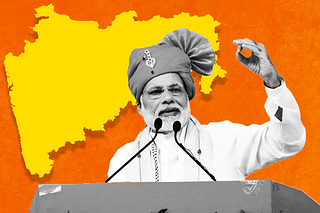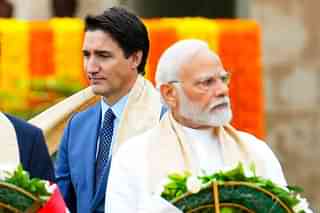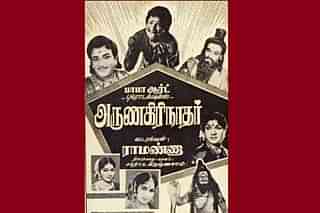Politics
Congress Freebies Could Damage Hard-Won Fiscal Success; Its Sums Don't Add Up
Sanjeev Nayyar
Apr 16, 2024, 01:01 PM | Updated 01:00 PM IST
Save & read from anywhere!
Bookmark stories for easy access on any device or the Swarajya app.
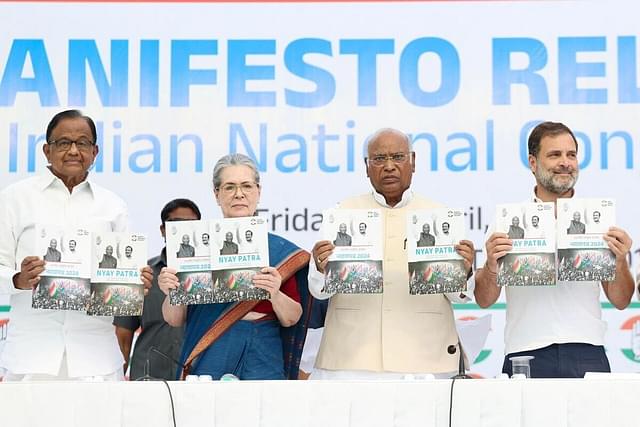
Last week, the Hindustan Times, Mumbai, carried a full-page advertisement of the five Nyay guarantees of the Congress. In particular, these promises caught my attention. I am listening to Rahul Gandhi’s speeches and am impressed.
There will be a Rs 1 lakh annual cash transfer to women. Two, the minimum wage per day for National Rural Employment Guarantee Act (NREGA) work would be Rs 400. Minimum support prices (MSPs) for agri-products are to be backed by a legal guarantee.
While the advertisement refers to a loan waiver for farmers, the farmers section of the Congress manifesto makes no reference to a loan waiver. On the Rs 1 lakh annual cash transfer to women, the manifesto states it is a transfer to those who are at the bottom of the income pyramid!
First, here is an overview of approximate cost of key promises:
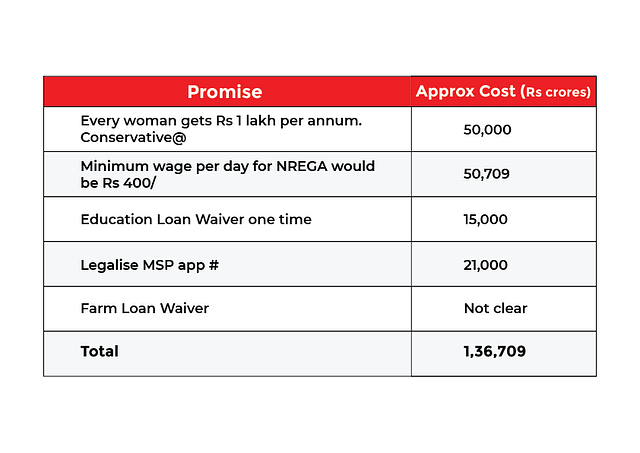
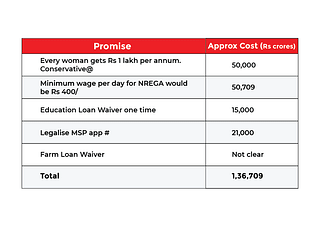
Since execution is not one of Congress’s strong points, actual costs could be higher.
For details, I have referred to the Congress manifesto. Read on...
1. Rs 1 lakh per annum to women.
Page 16 of the manifesto under a section titled "Women" reads: “Congress resolves to launch a Mahalakshmi scheme to provide Rs 1 lakh per year to every poor Indian family as an unconditional cash transfer. The poor will be identified among the families in the bottom of the income pyramid.”
So the Rs 1 lakh annual allowance is not for all women but only to women whose families are at the bottom of the income pyramid. What does bottom of the income pyramid mean? Is it those below the poverty line?
This bottom of the pyramid term was popularised by management guru C K Prahalad as a profitable consumer base in his 2004 book The Fortune at the Bottom of the Pyramid.
According to statistica.com, the number of women below the poverty line in 2022 was approximately 45 million (published by Manya Rathore).
So, the cost of this proposal is Rs 4.5 lakh crore per annum. According to World Population Prospects 2023, from the United Nations, in 2022-23, the poor population was close to 1 per cent. But 1 per cent of poor women is five million. If we use this number, the cost is Rs 50,000 crore per annum.
The cost depends on what number is used and the Congress party’s definition of poverty.
Note that currently approximately 81 crore beneficiaries are getting free foodgrains. The list of beneficiaries is decided by states. (Read: Centre must review NFSA beneficiaries for Budget. Use Aadhar database, not 2011 Census)
Will a Congress government ask states to do away with the allowances they give to women and consolidate them into a scheme run by the Centre? Will it make the families of women who receive this allowance ineligible to receive free foodgrains under the National Food Security Act (NFSA)?
When the United Progressive Alliance (UPA) passed the NFSA in 2013, few asked the Congress or Bharatiya Janata Party (BJP) thereafter where the money for free foodgrains (current cost: at least Rs 1.75 lakh crore) would come from?
2. Increase in wages under NREGA to Rs 400 per day.
Page 37 of the Congress manifesto reads: “We will increase the wages under MGNREGA to Rs 400 per day.”
To ascertain the additional cost we need to know the current cost and that the NREGA Act states that the government shall provide 100 mandays of work per rural household per annum. Here are actuals from NREGA site.
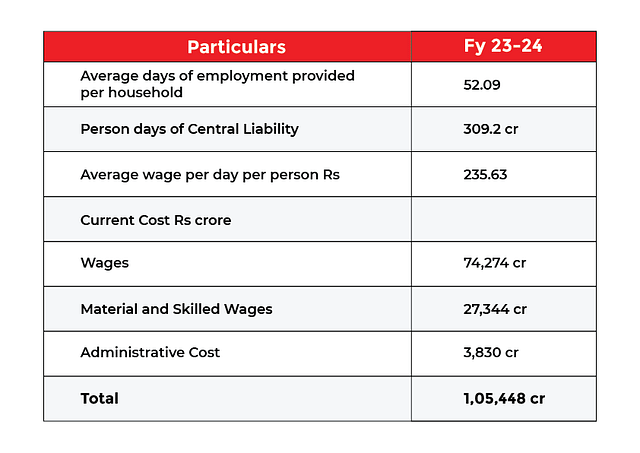
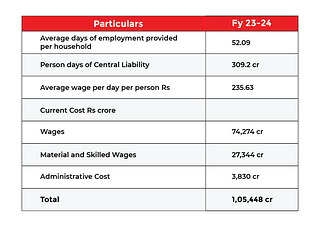
So, if the wages are increased from Rs 236 (average) to Rs 400 per day, the increase of Rs 164, assuming that in financial year 2024 (FY24) person days of the Centre’s liability and other elements of cost remain the same, it would result in an additional cost of Rs 50,709 crore, taking the total cost to Rs 1,56,157 crore.
The cost of an urban NREGA scheme cannot be quantified. But the amounts will be sizeable.
3. Farm Loan Waiver
According to a Mint report, the Congress manifesto said that “A Standing Farm Loan Waiver Commission will be set up to waive loans of farmers and determine the amount of the loan waiver that is required.” No loan waiver.
Page 18 of the manifesto reads: “We will appoint a Permanent Commission on Agricultural Finance that will report periodically on the extent of agricultural credit and the need for loan forbearance.” Note: the word waiver is not used.
Note also that the last big farm loan waiver was announced by UPA in 2008-09 and it was worth Rs 72,000 crore. But agriculture, being a state subject, many states announced farm loan waivers post-2014. The Punjab Farmers Kisan Credit Card outstandings are Rs 66,749 crore. (December 2023 report)
4. Waiver of Education Loans
Page 14 of the manifesto reads: “Due to widespread unemployment, as a one-time measure of relief, the amount due, including unpaid interest as on 15 March 2024, in respect of all student educational loans will be written off and the banks will be compensated by the government.”
Cost according to this Business Standard report is Rs 15,000 crore.
5. Legalising MSP
Page 18 of the manifesto reads, “Congress will give a legal guarantee to the Minimum Support Prices (MSP) announced by the government every year, as recommended by the Swaminathan Commission.”
A senior journalist, the late Sunil Jain, wrote in December 2020, “In case the MSP is guaranteed, and that will have to be for all crops and across the country — and once this is given, those growing other crops like fruits and vegetables will also demand MSP — the impact will be huge. The impact will differ from crop to crop, and even mandi to mandi, but given the difference between mandi prices and MSPs range between 20 per cent and 50 per cent, the cost to the government can run into several lakh crore rupees every year.” (Financial Express)
Making MSP a legal obligation can create complexities, warns agricultural economist Ashok Gulati.
He wrote in Moneycontrol.com, “A Crisil analysis indicates that if the government were to procure the entire output of the 23 crops for which MSP has been announced, it would require a working capital of nearly Rs 6 lakh crore during the current marketing season. This projection is based on the assumption of procuring crops that are exclusively trading below the MSP in mandis. However, the actual expense to the exchequer, considering the differential between MSP and mandi prices, is projected to be around Rs 21,000 crore for the 2023-24 marketing season.”
There must be a reason why the UPA refused the farmers’ demand to legalise MSPs.
6. We will amend the RTE Act to make education from Class I to Class XII in public schools compulsory and free.
One hopes that it is not only Hindu schools which will have to bear this cost since under the right to education (RTE), they have to reserve 25 per cent of their seats for nominees allocated by the government.
Note that in 2019, the Congress had promised a Minimum Income Guarantee Scheme. The 2019 Congress Manifesto (not available now) referred to NYAY as a joint scheme of the central and state governments. It would target five crore poorest families. Each family would be given an assured cash transfer of Rs 72,000 per annum. (Source)
All parties that offer freebies like the ones above must tell the public about the source of incremental government revenue that would be used to fund the expenditure.
If any political party continues with huge doles then what might happen?
If, thanks to excessive government expenditure, the combined Centre/state fiscal deficit crosses pre-determined limits it will increase inflation, a cost that will eventually be borne by the common man. Simply put, inflation is more money chasing fewer goods.
One of the reasons things are looking better today is macroeconomic stability on various fronts, including an improved current account deficit, robust banks and easing inflation pressure.
If one compares the current situation with UPA-2, macro-instability was then caused by fiscal expansion, high crude and food support prices, a 2013 run on the rupee, phone banking (ie, lending to cronies), banking sector problems and over-leveraging, etc.
It is because of macro-economic stability that Bloomberg and JP Morgan decided to include Government of India Bonds in their index. Since part of the budget deficit will be financed by foreign savings, it will relieve pressure on domestic savings, which can help bring down overall costs in the economy.
Causes of the 1991 Economic Crisis
Reason 5 has excerpts from Dr Manmohan Singh’s 1991 speech.
1. The immediate trigger was Iraq’s invasion of Kuwait and the spike in crude prices. It caused a balance of payment crisis. Those days deposits from non-resident Indians (NRIs) and remittances helped fund the trade deficit.
NRIs pulled out in light of the war. At that time, there were no foreign portfolio investors, and foreign direct investment was minimal. Foreign commercial borrowings fell too.
With a volatile Middle East and the Russian-Ukraine war, a possible surge in crude prices could recur.
2. All through the 1980s there was a fiscal expansion spree. There was a lot of foreign borrowings by the government and the public sector.
3. India ran a massive fiscal deficit and foreign debts soared. It was a deeper problem of the economic model being followed then.
4. “A fiscal deficit of 8 per cent of gross domestic product (GDP) and a current account deficit of 2.5 per cent of GDP all added to the government’s woes.” (Source ThePrint)
5. Excerpts from Dr Manmohan Singh’s budget speech of 1991, “The origins of the problem are directly traceable to large and persistent macroeconomic imbalances and the low productivity of investment, in particular the poor rates of return on past investments. There has been an unsustainable increase in government expenditure.
“During the fiscal year ending 31 March 1991 the wholesale price index registered an increase of 12.1 per cent, while the consumer price index registered an increase of 13.6 per cent.”
Nothing comes free. The choice is yours.
(Note: Utmost care was taken in information collection. Errors, if any are without malafide intent).
Also Read:
Why are Punjab farmers protesting
Why it is necessary to diversify the farming basket
Farmers will shift from Paddy only when...
Freebies could lead to a 1991 type crisis
Save & read from anywhere!
Bookmark stories for easy access on any device or the Swarajya app.
The writer is an independent columnist, travel photojournalist and chartered accountant, and founder of eSamskriti. He tweets at @sanjeev1927.
Introducing ElectionsHQ + 50 Ground Reports Project
The 2024 elections might seem easy to guess, but there are some important questions that shouldn't be missed.
Do freebies still sway voters? Do people prioritise infrastructure when voting? How will Punjab vote?
The answers to these questions provide great insights into where we, as a country, are headed in the years to come.
Swarajya is starting a project with an aim to do 50 solid ground stories and a smart commentary service on WhatsApp, a one-of-a-kind. We'd love your support during this election season.
Click below to contribute.

